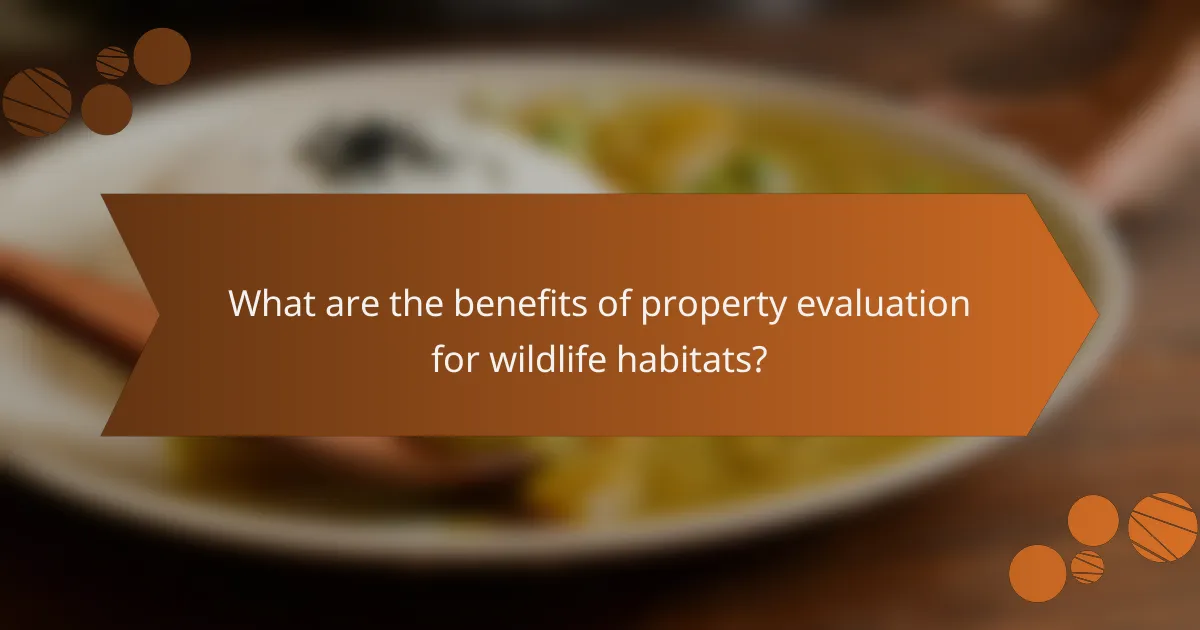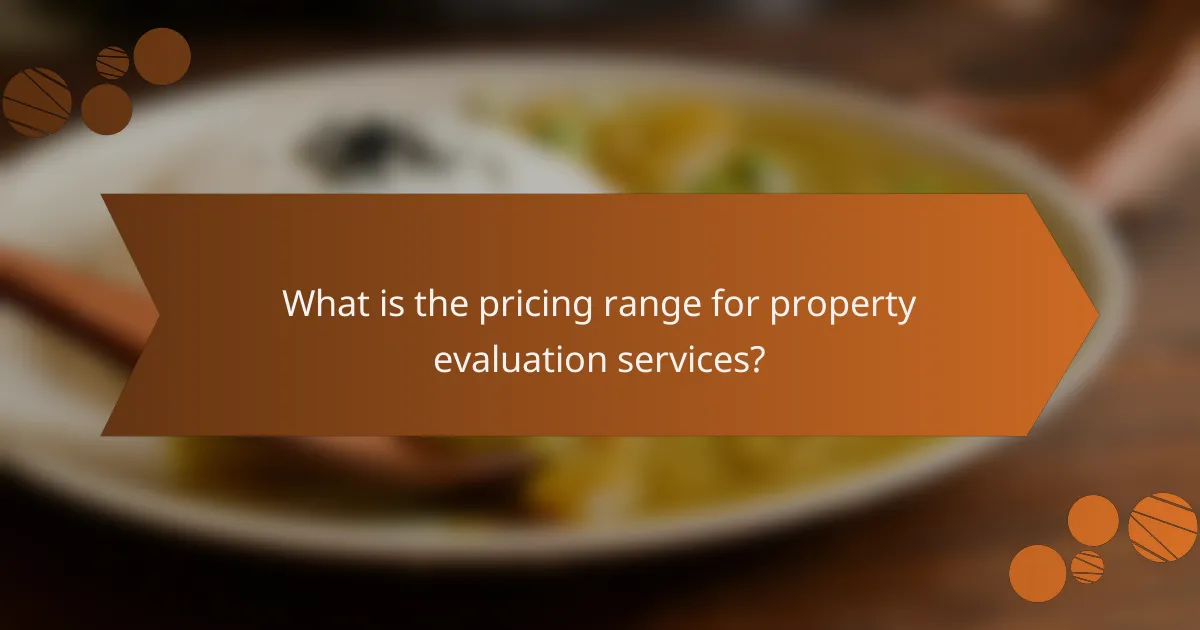In Los Angeles, property evaluation services play a crucial role in assessing land for development, conservation, and investment opportunities. These evaluations not only include site assessments and environmental impact analyses but also focus on the potential for wildlife habitats, ensuring that areas are suitable for diverse species. By implementing strategic improvements such as restoring native plants and managing invasive species, these services contribute to promoting biodiversity and ecological balance in the region.

What property evaluation services are available in Los Angeles?
Los Angeles offers a variety of property evaluation services that help assess land for development, conservation, and investment. These services include site assessments, environmental impact analyses, soil testing, land use planning, and property value estimations, all tailored to meet local regulations and market conditions.
Site assessment services
Site assessment services in Los Angeles evaluate the physical characteristics of a property, including topography, vegetation, and existing infrastructure. These assessments help identify potential challenges and opportunities for development or conservation efforts.
Professionals typically conduct on-site inspections and may utilize tools like GIS mapping to gather data. This information is crucial for making informed decisions about land use and potential improvements.
Environmental impact analysis
Environmental impact analysis assesses how a proposed project may affect the surrounding environment, including wildlife habitats, air quality, and water resources. In Los Angeles, these analyses are often required for compliance with local and state regulations.
These studies involve evaluating potential risks and benefits, and they may suggest mitigation strategies to minimize negative impacts. Engaging with local environmental agencies early in the process can streamline approvals and enhance project sustainability.
Soil testing services
Soil testing services determine the composition and quality of soil on a property, which is essential for agricultural, construction, and landscaping purposes. In Los Angeles, soil tests can reveal nutrient levels, pH balance, and contamination issues.
Testing typically involves collecting soil samples and analyzing them in a laboratory. Results guide decisions on soil amendments, plant selection, and construction methods, ensuring that projects are viable and environmentally responsible.
Land use planning
Land use planning in Los Angeles involves strategizing how land can be developed or preserved to meet community needs while adhering to zoning laws. This process considers factors like population growth, infrastructure, and environmental sustainability.
Effective land use planning requires collaboration with local government, stakeholders, and community members. Utilizing comprehensive plans can help align development goals with community values and regulatory requirements.
Property value estimation
Property value estimation assesses the market value of a piece of land based on various factors, including location, size, and zoning. In Los Angeles, these estimates are crucial for buyers, sellers, and investors to make informed financial decisions.
Factors influencing property value include recent sales of comparable properties, current market trends, and potential future developments in the area. Engaging a qualified appraiser can provide a detailed analysis and help avoid common pitfalls in property transactions.

How can wildlife habitat potential be assessed?
Wildlife habitat potential can be assessed through various methods that evaluate the suitability of an area for different species. This involves examining the physical environment, available resources, and existing wildlife populations to determine how well the habitat can support diverse species.
Wildlife surveys
Wildlife surveys are systematic methods used to collect data on animal populations and their behaviors within a specific area. These surveys can include direct observation, camera traps, and audio recordings to identify species presence and abundance. Regular surveys help track changes in wildlife populations over time, providing insights into habitat health.
When conducting wildlife surveys, consider the timing and frequency to capture seasonal variations in species activity. Engaging local experts can enhance survey accuracy and efficiency.
Habitat mapping techniques
Habitat mapping techniques involve creating visual representations of the landscape to identify different habitat types and their characteristics. Geographic Information Systems (GIS) are commonly used to analyze spatial data, allowing for detailed mapping of vegetation, water sources, and topography.
Effective habitat mapping requires integrating various data sources, such as satellite imagery and field surveys. This approach helps prioritize areas for conservation efforts and habitat restoration, ensuring resources are allocated effectively.
Species inventory assessments
Species inventory assessments provide a comprehensive list of all species present in a habitat, including plants, animals, and microorganisms. These assessments help determine biodiversity levels and identify species that may require special conservation measures.
To conduct an inventory, utilize a combination of field surveys, remote sensing, and existing databases. Regular updates to the inventory are essential to reflect changes in species populations and distributions, which can be influenced by environmental factors and human activities.

What improvements can enhance wildlife habitats?
Enhancing wildlife habitats involves strategic actions that promote biodiversity and ecological balance. Key improvements include restoring native plants, managing invasive species, and enhancing water sources to create a thriving environment for various wildlife species.
Native plant restoration
Restoring native plants is crucial for improving wildlife habitats, as these species are adapted to local conditions and provide essential food and shelter for native wildlife. Focus on planting a variety of native species that bloom at different times to support pollinators throughout the growing season.
Consider creating a diverse plant community that includes grasses, shrubs, and trees. This diversity not only attracts a wider range of wildlife but also improves soil health and reduces the need for chemical fertilizers.
Invasive species management
Managing invasive species is vital for protecting native ecosystems. Invasive plants can outcompete native flora, leading to a decline in local wildlife populations. Regular monitoring and removal of invasive species can help restore balance in the habitat.
Utilize methods such as manual removal, mulching, or targeted herbicide application, ensuring compliance with local regulations. Educating the community about the impacts of invasive species can also foster collective action toward habitat improvement.
Water source enhancement
Enhancing water sources is essential for supporting wildlife, as many species rely on water for drinking, breeding, and foraging. Creating or restoring ponds, wetlands, or streams can significantly increase habitat quality.
When enhancing water sources, consider the natural landscape and local hydrology. Implementing features like shallow edges or native vegetation around water bodies can provide critical habitat for amphibians and birds while improving water quality.

What are the benefits of property evaluation for wildlife habitats?
Property evaluation for wildlife habitats identifies the potential of a given area to support various species and enhance ecological health. This process helps landowners understand how their property can contribute to biodiversity and ecosystem services while informing management practices that benefit both wildlife and human interests.
Increased biodiversity
Evaluating property for wildlife habitats can significantly boost biodiversity by identifying areas that can support a variety of species. This assessment often includes analyzing vegetation types, water sources, and existing wildlife populations, which helps determine how to enhance habitat quality.
For example, creating native plant gardens or restoring wetlands can attract more species, including pollinators and birds. Landowners should consider implementing practices such as planting diverse flora and providing shelter to maximize the potential for increased biodiversity.
Enhanced ecosystem services
Property evaluations also reveal opportunities to improve ecosystem services, which are the benefits humans derive from nature, such as clean air, water filtration, and carbon sequestration. By understanding the ecological functions of their land, property owners can implement strategies that enhance these services.
For instance, maintaining riparian buffers along waterways can improve water quality and reduce erosion. Additionally, integrating sustainable land management practices can lead to healthier soils and increased resilience against climate change, ultimately benefiting both wildlife and local communities.

What criteria should be considered for selecting a property evaluation service?
When selecting a property evaluation service, consider their experience, client feedback, and the range of services they offer. These factors can significantly impact the accuracy and reliability of the evaluation, ensuring that you make informed decisions regarding property value and potential improvements.
Experience and expertise
Look for property evaluation services with a strong track record and relevant expertise in your specific area. Professionals should have experience in local property markets and knowledge of wildlife habitat assessments, which can influence property value and development potential.
Verify credentials and certifications, as these can indicate a level of professionalism and adherence to industry standards. A service with years of experience is likely to provide more accurate evaluations and insights.
Client reviews and testimonials
Client reviews and testimonials are valuable resources for gauging the quality of a property evaluation service. Look for feedback on their reliability, thoroughness, and customer service. Positive reviews often highlight successful evaluations and satisfied clients.
Consider checking independent review platforms or asking for references directly from the service. A service with consistently high ratings is more likely to meet your expectations.
Service offerings
Evaluate the range of services offered by property evaluation companies. Some may specialize in specific areas, such as wildlife habitat potential assessments, while others provide comprehensive evaluations that include market analysis and property improvement recommendations.
Ensure that the service can customize their offerings to meet your unique needs. For instance, if you are interested in enhancing wildlife habitats, confirm that the service has expertise in this area and can provide actionable insights.

What is the pricing range for property evaluation services?
The pricing for property evaluation services typically ranges from a few hundred to several thousand dollars, depending on factors like location, property size, and the complexity of the evaluation. Basic evaluations may cost around $300 to $600, while comprehensive assessments can exceed $2,000.
Factors Influencing Property Evaluation Costs
Several factors can influence the cost of property evaluation services. Location plays a significant role; urban areas often have higher fees due to increased demand and living costs. Additionally, the size and type of property, such as residential, commercial, or agricultural, can affect pricing.
The complexity of the evaluation is another critical factor. Properties with unique features or those requiring extensive research may incur higher costs. For example, evaluating a property with significant wildlife habitat potential may require specialized expertise, impacting the overall price.
Typical Services Included in Evaluations
Property evaluations generally include a range of services, such as site assessments, market analysis, and recommendations for improvement. Evaluators often conduct physical inspections to assess the condition of the property and its surroundings.
In addition to these standard services, evaluations may also provide insights into wildlife habitat potential, which can be particularly valuable for landowners interested in conservation or development. This can include assessments of existing flora and fauna, as well as recommendations for habitat enhancement.
Tips for Choosing an Evaluation Service
When selecting a property evaluation service, consider the evaluator’s qualifications and experience. Look for professionals with relevant certifications and a solid track record in property assessments. It’s also wise to request references or reviews from previous clients.
Compare quotes from multiple evaluators to ensure you receive a fair price. Be cautious of extremely low bids, as they may indicate a lack of thoroughness or expertise. Finally, clarify what services are included in the quoted price to avoid unexpected costs later on.
